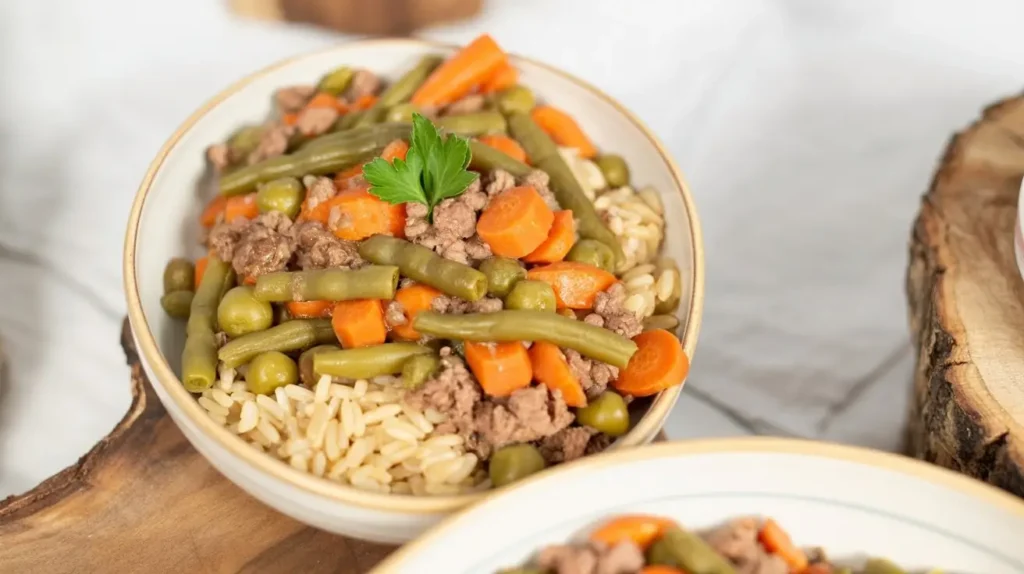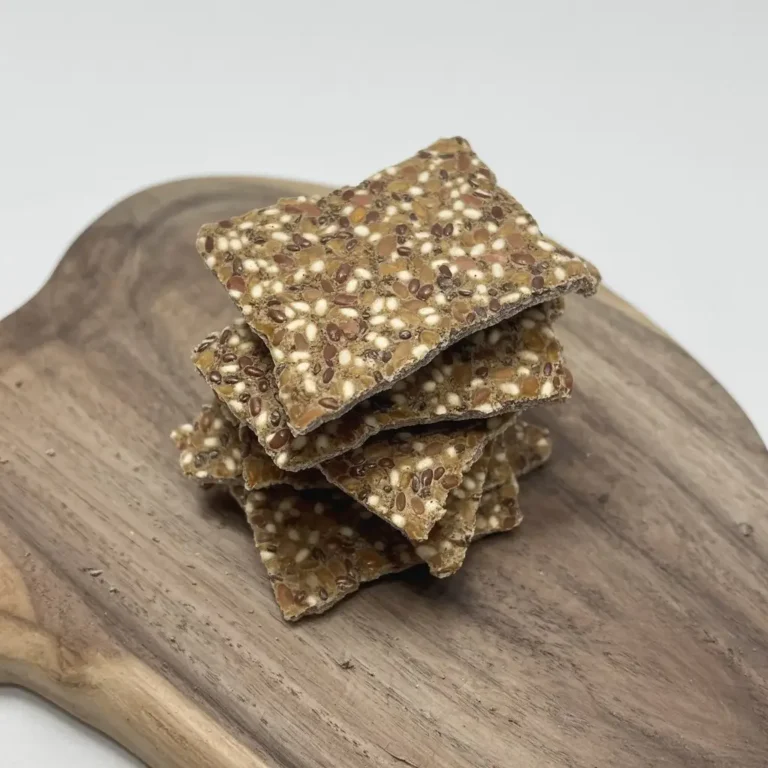
You know that moment when you’re staring at the ingredient list on your puppy’s kibble and you can’t pronounce half the words?
Yeah, I’ve been there too.
Here’s the thing most people don’t realize: making nutritionally complete puppy food at home isn’t rocket science. But it’s not just throwing some chicken and rice in a bowl either.
Today I’m going to walk you through exactly how to create a vet-approved, nutritionally balanced homemade puppy food that will have your little furball bouncing off the walls (in the best way possible).
What You’ll Need
Protein Sources
- 2 1/4 pounds ground beef (15% lean fat content)
- 75g beef liver (about 2.6 oz)
- 1 1/4 cups sardines in water, canned (drained)
Vegetables & Produce
- 3/4 cup cauliflower (chopped into small florets)
- 3/4 cup sweet potato (diced into small cubes)
Additional Essentials
- 2 large eggs (or 100g if measuring by weight)
- 1 tablespoon hemp seed oil
- 1/3 cup essential nutrient mix (specifically formulated for puppies)
- 2 1/2 grams Himalayan salt
- 15g ground pumpkin seeds
- 1/2 gram nutritional yeast
- 1/2 gram wheat grass powder
- 2 cups water
Note: This recipe is suitable for puppies over 14 weeks old. Always consult your vet before switching your puppy’s diet.
Pro Tips
1. Scale matters when it comes to nutrition. If you’re serious about making homemade puppy food, invest in a kitchen scale that measures in grams. Eyeballing ingredients might work for your Sunday pancakes, but your puppy’s growing body needs precision. Nutrient ratios can make or break proper development.
2. Source quality liver from a trusted butcher. I get my beef liver from a local farm that raises grass-fed cattle. The difference in color and smell is night and day compared to grocery store liver. Your puppy’s developing immune system will thank you.
3. Prep vegetables properly for maximum absorption. Puppies can’t break down raw vegetables like adult dogs can. I blanch the cauliflower for 2-3 minutes and steam the sweet potatoes until they’re fork-tender. This makes the nutrients more bioavailable and easier on their developing digestive systems.
4. Cool completely before serving. I learned this the hard way when my eager pup burned his tongue on freshly cooked food. The ideal serving temperature is room temperature or slightly warm to touch. Remember, puppies are more sensitive to temperature extremes than adult dogs.
5. Make feeding time consistent. Puppies thrive on routine, especially when transitioning to homemade food. I serve this recipe at the exact same times every day – 7 AM, 12 PM, and 5 PM. It helps their digestive system adapt and reduces the chance of upset stomachs.
Required Tools
- Large skillet or heavy-bottomed pot
- Kitchen scale (digital, measuring in grams)
- Sharp chef’s knife
- Cutting board
- Large mixing spoon or spatula
- Fine-mesh strainer (for draining sardines)
- Storage containers (glass or BPA-free plastic)
- Measuring cups and spoons
- Steamer basket or pot for blanching vegetables
Substitutions and Variations
Protein Swaps:
- Replace ground beef with ground turkey (adjust cooking time as turkey cooks faster)
- Substitute chicken liver for beef liver (use same amount)
- Swap sardines for mackerel or wild-caught salmon (canned in water only)
Vegetable Alternatives:
- Use frozen cauliflower instead of fresh (no need to thaw first)
- Replace sweet potato with butternut squash or carrots
- Green beans can substitute for cauliflower in a pinch
For Dogs with Sensitivities:
- Omit eggs if your puppy has egg allergies (increase ground beef by 50g)
- Use coconut oil instead of hemp seed oil for dogs sensitive to hemp
- Replace beef with lamb for dogs with beef sensitivities
Make Ahead Tips
This recipe is perfect for meal prep. I make a double batch every Sunday and portion it into glass containers. Here’s my system:
- Cook the full recipe and let it cool completely
- Divide into daily portions based on your puppy’s weight
- Store 3 days’ worth in the refrigerator
- Freeze the rest in individual portions for up to 90 days
- Thaw frozen portions in the fridge overnight before serving
Pro tip: I use ice cube trays to freeze single-serving portions for smaller puppies. Once frozen solid, pop them out and store in freezer bags.
Step-by-Step Instructions
Step 1: Prep Your Vegetables Start by washing and chopping your cauliflower into small, bite-sized florets. Dice the sweet potato into 1/2-inch cubes. The smaller pieces cook faster and are easier for puppies to digest.
Step 2: Begin Cooking the Protein In your large skillet, add the 2 cups of water and ground beef. Break up the meat with your spatula as it cooks over medium heat for about 5 minutes. The meat should start browning but doesn’t need to be fully cooked yet.
Step 3: Add the Organ Meat Chop the beef liver into small pieces and add it to the skillet with the ground beef. Liver can smell strong, but it’s packed with essential nutrients puppies need for proper growth. Cook for another 3-4 minutes.
Step 4: Incorporate the Vegetables Add your chopped cauliflower and diced sweet potato to the skillet. Stir everything together and continue cooking until the vegetables are tender and the meat is fully browned – about 8-10 minutes total.
Step 5: Add Remaining Ingredients Turn off the heat. This is important – we don’t want to cook the sardines or eggs. Drain your sardines and add them to the mixture along with the raw eggs. The residual heat will gently cook the eggs without making them rubbery.
Step 6: Final Seasoning and Mixing Stir in the hemp seed oil, ground pumpkin seeds, Himalayan salt, nutritional yeast, and wheat grass powder. Add your essential nutrient mix last and stir thoroughly to ensure even distribution.
Step 7: Cool and Serve Remove from heat and let the mixture cool to room temperature before serving. This takes about 20-30 minutes, depending on room temperature.
Nutritional Breakdown
This recipe provides approximately:
Per 100g serving:
- Calories: 195 kcal
- Protein: 16.2g (33% of calories)
- Fat: 11.8g (54% of calories)
- Carbohydrates: 6.5g (13% of calories)
- Calcium: 1.4% (dry matter basis)
- Phosphorus: 1.0% (dry matter basis)
- Calcium:Phosphorus ratio: 1.4:1
Key Nutrients for Puppy Development:
- Essential amino acids from multiple protein sources support muscle growth
- Omega-3 fatty acids from sardines promote brain and eye development
- Vitamin A and beta-carotene from sweet potatoes support immune function
- B-vitamins from liver aid in energy metabolism
- Controlled calcium levels prevent developmental orthopedic disease
This recipe meets AAFCO requirements for puppy growth including appropriate calcium and phosphorus ratios specifically formulated for large breed puppies.
Diet-Specific Modifications
For Large Breed Puppies (over 70 lbs adult weight): This recipe is specifically formulated with controlled calcium levels (1.4% dry matter) to prevent developmental orthopedic diseases common in large breeds.
For Small Breed Puppies: Increase the calcium content slightly by adding 1 tablespoon of ground eggshells to the mixture.
For Puppies with Allergies:
- Remove common allergens like eggs or beef based on your vet’s recommendations
- Substitute single-protein sources to identify triggers
- Always introduce new ingredients one at a time
Meal Pairing Suggestions
Morning Meal: Serve with a small amount of plain Greek yogurt for probiotics Afternoon Meal: Add a teaspoon of bone broth for extra hydration Evening Meal: Include a few frozen blueberries as a healthy dessert
Cooking Time Efficiency Tips:
- Prep vegetables the night before and store in the fridge
- Cook liver and ground beef together in large batches and freeze portions
- Use a food processor to quickly chop vegetables uniformly
- Double the recipe and freeze half to save time next week
Leftovers and Storage
Refrigerator Storage:
- Store in airtight glass containers for up to 3 days
- Portion into daily servings for easy access
- Always check for any off smells before serving
Freezer Storage:
- Freeze in single-serving portions for up to 90 days
- Use freezer-safe containers or freezer bags
- Label with date and serving size for easy identification
- Thaw overnight in refrigerator before serving
Reheating Instructions: Serve at room temperature or slightly warm. If reheating from frozen, thaw completely first, then warm gently in microwave for 10-15 seconds. Never serve hot food to puppies.
Frequently Asked Questions
Q: How much should I feed my puppy? A: As a general rule, feed about 1 cup of prepared food per 10 pounds of puppy weight, divided into 3-4 meals daily. However, every puppy is different. Monitor your pup’s weight and body condition, and adjust portions accordingly. Your vet can provide specific feeding guidelines based on your puppy’s breed and growth rate.
Q: Can I use this recipe for adult dogs? A: This recipe is specifically formulated for growing puppies and has higher fat and protein content than adult dogs typically need. For adult dogs, you’d want to adjust the ratios and possibly add more vegetables. Consult with a veterinary nutritionist for adult dog formulations.
Q: What if my puppy has diarrhea after switching? A: Digestive upset is common when transitioning to any new food. Always transition gradually over 7-10 days, mixing increasing amounts of homemade food with decreasing amounts of their current food. If diarrhea persists beyond 48 hours, contact your vet immediately.
Q: Is it really cheaper than commercial puppy food? A: In my experience, yes – but it depends on ingredient quality. Using organic, grass-fed ingredients costs more upfront but provides better nutrition per dollar. When I factor in potential vet bills from poor nutrition, homemade food is an investment in long-term health.
Q: Do I need to add supplements? A: This recipe includes an essential nutrient mix to ensure nutritional completeness. However, some puppies may need additional supplements based on their individual needs. Work with your vet to determine if your pup needs extra vitamin D, calcium, or other nutrients.
Q: Can I prepare this in bulk? A: Absolutely! I recommend making 2-3 days’ worth at a time for freshness. You can prep larger batches and freeze portions, but the texture of some vegetables changes slightly after freezing. Fresh is always best when possible.
Q: What about raw vs. cooked? A: This recipe uses gentle cooking to make nutrients more bioavailable while reducing bacterial risk. Research from the University of Illinois shows that fresh, lightly cooked foods are highly digestible for dogs, making them an excellent choice for developing puppies.
Wrap Up
Making nutritionally complete homemade puppy food isn’t just about giving your furry friend better ingredients – it’s about taking control of their health from day one.
Studies show that dogs fed fresh diets can live up to 2.5 years longer than those on commercial diets, and the benefits start in puppyhood. When you know exactly what’s going into your puppy’s bowl, you’re setting them up for a lifetime of better health, stronger immunity, and fewer vet visits.
The best part? Once you get the hang of it, this recipe takes less than 30 minutes to make and costs about the same as premium kibble.
Your puppy deserves the best start in life, and it begins with what you put in their bowl.
Give this recipe a try this week and let me know how your little one likes it! Drop a comment below with your pup’s reaction, any modifications you made, or questions about adapting the recipe for your specific breed. I read every single comment and love hearing about your homemade feeding adventures.
And if you’re feeling overwhelmed about the transition, remember – you don’t have to switch overnight. Start by replacing one meal a day with homemade food and gradually work your way up. Your puppy (and your peace of mind) will thank you for it.






